After knowing all these amazing Purslane Benefits, you’d be tempted to know How To Grow Purslane In Containers for sure!
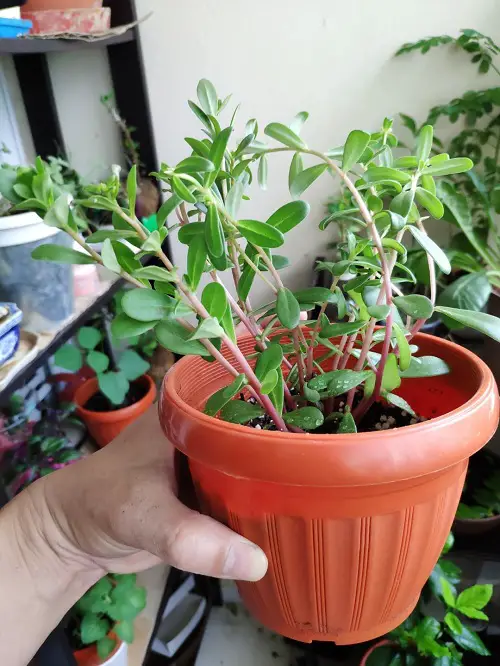
Purslane can be easily uprooted alongside other useless weeds. However, experts have recently unmasked a few unmistakably helpful properties associated with this plant. Let’s have a detailed look at the Purslane Benefits and How To Grow Purslane In Containers!
Did you know purslane is a succulent? Learn about other edible succulents here!
Purslane Benefits
1. A Great Spinach Substitute!
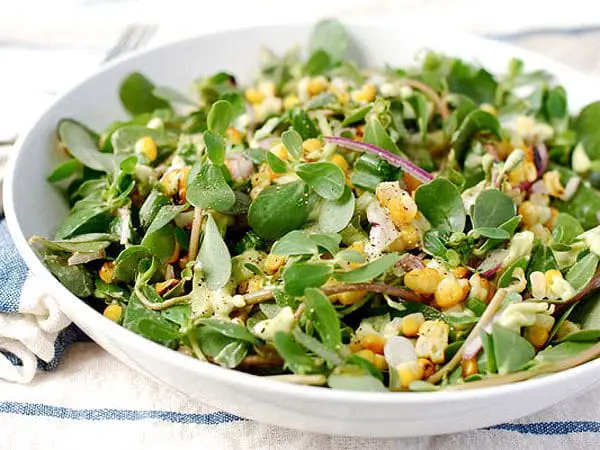
Purslane tastes great when mixed with salads and sandwiches. Besides safeguarding the eater from heart diseases and related complications such as stroke, this herb is also an awesome source of healthy proteins.
According to the research report published in Scientific World Journal, Purslane has 5 times higher Omega-3 fatty acids than spinach, 7 times higher alpha-tocopherol (Vitamin E) than Spinach, and a higher amount of Vitamin C and beta-carotene than Spinach. You can read the full report here!
Recent medical research findings included this little-known edible plant among foods that curb Autism and Attention Deficit Hyperactivity Disorder(ADHD) in young children.
This means that menus comprising this important weed can improve your concentration. Helpful, if your little one finds it hard to focus on the classwork.
2. More Omega-3 Fatty Acids than Any Other Leafy Vegetable

Omega-3 fatty acids are essential for human growth, development, and prevention of numerous cardiovascular diseases, and maintenance of a healthy immune system.
Extremely rare but inestimably necessary that can only be found in very few other edibles like avocados, flax seeds, chia seeds, walnuts, fishes, and of course, purslane.
In fact, purslane is the richest source of Omega-3 fatty acids when it comes to vegetables, and has it 5 times higher than spinach! Learn more about the benefits of Omega-3 fatty acids here!
3. Amazing Source of Essential Vitamins & Antioxidants
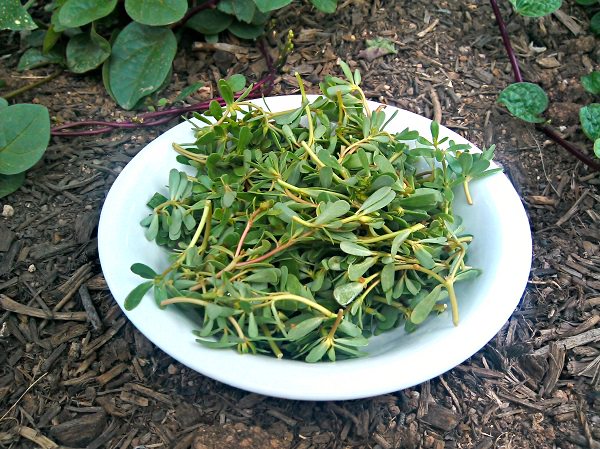
Antioxidants are one of the few nutritional components that prevent multiple diseases. Purslane is an excellent source of vitamin A that improves vision and is also important for the skin growth and development of skin tissues.
Aside from this, vitamin A from natural sources such as plants and fruits helps prevent oral cavity and lung cancer. The pigments of the weed are also important in this respect. The pigments are basically two types of betalain.
The red pigment at the base of the stems is β-cyanins, and the yellow pigment is β –xanthins. Both are antioxidants, which have been shown to have antimutagenic properties that make them essential in protecting our cells.
It is at the top of the list when it comes to plants rich in vitamin E and also has the highest content of alpha-linolenic acid (ALA), an essential Omega-3 fatty acid.
The weed has a higher amount of beta carotene and 7 times more vitamin E than spinach. Other nutrients that can also be found in the weed include magnesium, vitamin C, potassium, riboflavin, and phosphorus.
4. It Helps in Curing Skin Diseases & Gastrointestinal Complications

Purslane benefits also include curing and alleviating skin diseases and gastrointestinal complications. It’s rich in vitamin A, which plays a vital role in normal skin development.
In a similar vein, it also helps in having proper digestion of food. This is the reason most herbal treatments for stomach disorders often include this plant’s therapeutic extracts.
5. It Contains Bone-Strengthening Minerals
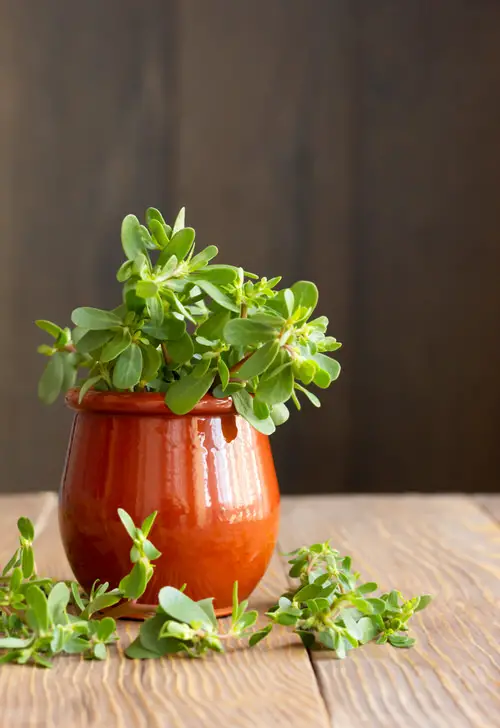
The herbal compounds in purslane help in nurturing strong bones. The plant features a group of essentially beneficial minerals like calcium and magnesium.
It is also rich in potassium and iron – another highly nourishing pair that we all need for robust bones and sound inter-bone tissues.
The weed is also a good natural ingredient for mitigating and preventing some of the most incapacitating joint problems such as arthritis and osteoporosis.
How to Grow Purslane in Containers?
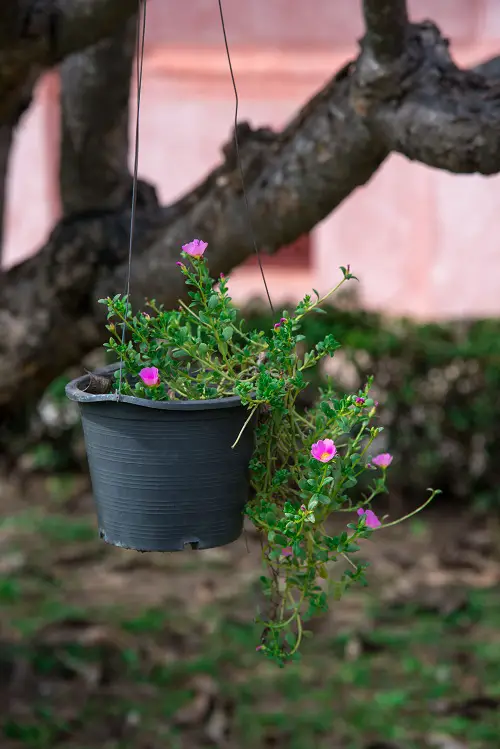
Growing purslane in containers as a leafy green is also possible. Either buy purslane (Portulaca oleracea L.) seeds online or try to find purslane growing wild somewhere. It can be grown both from seeds and cuttings.
- Choose a container or hanging basket that is at least 6-8 inches deep and 8-10 inches wide. You also have an option to grow it in hanging baskets.
- Don’t care about spacing. You can grow a lot of plants in such a container.
- Water the plant moderately, this weed is tolerable to underwatering and overwatering.
- You don’t need to fertilize it regularly, the addition of compost or well-rotted manure to the soil is fine and enough.
- In frost-free climates, you can grow it year-round. In cooler zones, start planting from the spring.



How can I be sure it is definitely purslane. Sound very interesting but I am afraid of getting poisoned.
Fortunately, there aren’t too many plants that can be easily confused with purslane. The closest common one, at least to me here in coastal California, is spurge, which has milky sap. So if you see the red stems and teardrop shaped leaves low to the ground, and if when you break a stem it is aloe vera like and not milky or sticky, you should be good to go. You can always purchase purslane seeds, too.
Yes, this. Spurge is a close lookalike for purslane, but spurge has white sap and purslane doesn’t. CHECK THE SAP AT THE PLANT’S STEM, not the leaves.
Also, spurge’s leaves do not get thick like purslane, and tend to be flatter and paired side to side on the stem.
But, even if everything checks out, start with small amounts and check your reaction. Build up to reasonable serving sizes, just in case.
Also, purslane is high in oxalic acid, which is hard on the body. Dont make it a dietary staple, a couple salads in a month or the occasional purslane and garlic saute are great, but let your body process the oxalic acid out, dont overwhelm yourself with it. This also goes for other greens, like sorrel, chard, spinach, and others, and plants like rhubarb. Balance and variety are key.
Afraid of die out of poisoned plant ? Just make it a tea and storage on the freezer. Kills all the killers.